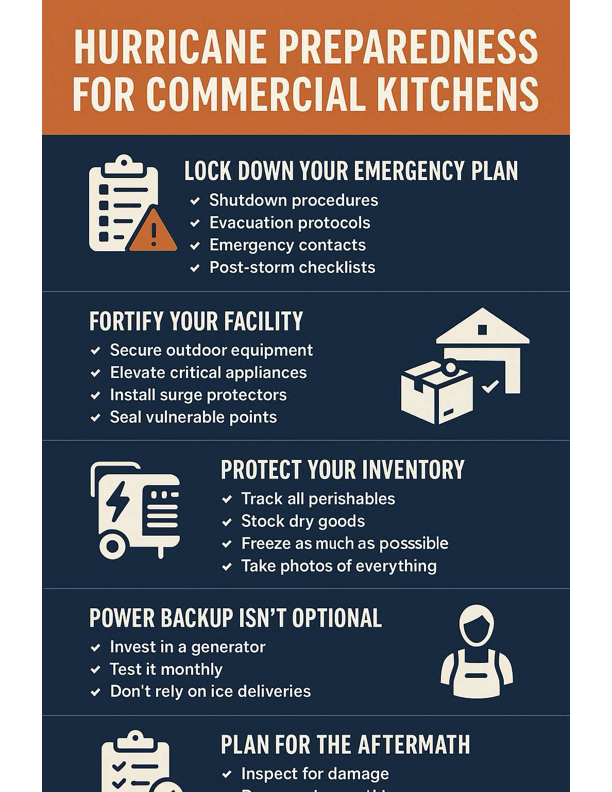When a hurricane threatens South Florida, commercial kitchens are on the front lines of disruption. From power outages and flooding to supply chain delays and spoiled inventory, one storm can shut down your operation—and cost you thousands. The key to survival? Plan like it’s going to happen, because it will.
Here’s a clear, no-fluff guide to hurricane preparedness for restaurants, caterers, and commercial foodservice operators in South Florida.
1. Lock Down Your Emergency Plan
If you don’t already have one, write a hurricane response plan today. It should cover:
-
Shutdown procedures (who does what and when)
-
Evacuation protocols for staff
-
Emergency contacts (utilities, suppliers, property manager, insurance)
-
Post-storm checklists for reopening safely
Don’t just write it—train your team on it. Have a dry run before hurricane season peaks.
2. Fortify Your Facility
Commercial kitchens are full of equipment that can be damaged by water or wind. Before a storm hits:
-
Secure or move outdoor equipment and furniture.
-
Elevate critical appliances like refrigerators, freezers, and control panels if flooding is a risk.
-
Install surge protectors or disconnect equipment to prevent damage.
-
Seal vulnerable points like back doors, vents, and drains to minimize water intrusion.
Consider flood barriers or sandbags if your location is prone to storm surge.
3. Protect Your Inventory
A hurricane can wipe out your inventory in hours if you’re not ready. Take steps to:
-
Track all perishables and prioritize what can be moved or used before the storm.
-
Stock dry goods and shelf-stable essentials in airtight containers.
-
Freeze as much as possible ahead of time—every extra degree buys you time.
-
Take photos of everything for insurance records.
Don’t wait until shelves are empty. Keep a rolling stock of emergency water, batteries, and non-perishable food supplies.
4. Power Backup Isn’t Optional
In Florida, power loss is guaranteed in a major storm. You need a plan to keep cold storage running:
-
Invest in a generator sized for your needs—at least to support freezers, fridges, and basic lighting.
-
Test it monthly and keep enough fuel for at least 3 days.
-
Don’t rely on ice deliveries—everyone will be calling the same suppliers post-storm.
If a generator isn’t in your budget, consider partnering with a nearby business or shared-use kitchen.
5. Prep Your Team
Your staff needs clear instructions before, during, and after the storm.
-
Communicate early and often. Use group texts or apps like GroupMe or WhatsApp.
-
Assign roles. Who’s responsible for securing equipment? Who checks inventory?
-
Be flexible. Many employees will have their own families and priorities.
Consider offering support like cash advances, emergency kits, or temporary accommodations to your team if your business can afford it. Loyalty goes both ways.
6. Plan for the Aftermath
Once the storm passes, safety comes first:
-
Inspect for damage before entering. Look for gas leaks, electrical issues, and structural problems.
-
Document everything. Photos, receipts, logs—insurance claims depend on it.
-
Check food safety. If in doubt, throw it out. Florida health inspectors won’t be lenient.
Have a plan to reopen quickly and safely—or pivot to catering, takeout, or mobile options if your dining room is down.
Final Word: Hope Is Not a Strategy
In South Florida, hurricane season isn’t a surprise. It’s a test. The kitchens that prepare survive. The ones that don’t... don’t.
Treat every June to November like game time. Secure your people, your property, and your plan. Because when the wind picks up, it’s already too late to wonder what you should have done.

